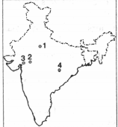Arihant Expert Team Solutions for Exercise 1: Exercise 1
Arihant Expert Team General Knowledge/ General Awareness Solutions for Exercise - Arihant Expert Team Solutions for Exercise 1: Exercise 1
Attempt the free practice questions from Exercise 1: Exercise 1 with hints and solutions to strengthen your understanding. IAS (PRE) General Studies Paper 1 solutions are prepared by Experienced Embibe Experts.
Questions from Arihant Expert Team Solutions for Exercise 1: Exercise 1 with Hints & Solutions
Examine the map given below
The places marked 1, 2, 3 and 4 respectively the seats of powers of the
The following items consist of two statements, one labelled as 'Assertion (A)' and the other labelled as 'Reason (R)'. You are to examine these two statements carefully and decide if the 'Assertion (A)' and the 'Reason (R)' are individually true and if so, Whether the Reason is a correct explanation of the Assertion:
Assertion (A) Partition of Bengal in 1905 brought to an end the moderates' role in the Indian freedom movement.
Reason (R) The Surat session of Indian National Congress separated the extremists from the moderates.
In the year 1613, where was the English East India Company given permission to set up a factory (trading post)?
By regulation in 1793, the District Collector was deprived of his judicial powers and made the collecting agent only. What was the reason for such regulation?
Mahatma Gandhi undertook Fast unto death in 1932, mainly because
Consider the following statements :
1. The first woman President of the Indian National Congress was Sarojini Naidu.
2. The first Muslim President of the Indian National Congress was Badruddin Tyabji.
Which of the statement(s) given above is/are coned?
The Montague-Chelmsford Proposals were related to
In the context of Indian history, what is the principle of 'Dyarchy'?

